Nature is one of Japan’s most attractive qualities, captivating visitors and residents alike with its breathtaking landscape and seasonal phenomena. Among these natural wonders, spring flowers hold a special place in the hearts of locals and tourists. The blooming of spring flowers in Japan brings a kaleidoscope of bright colours, floral fragrance in the wind, and the brightening of our moods.
In this article, we introduce the different types of spring flowers in Japan. Not just cherry blossoms, there are Japanese wisteria, tulips, spring roses, nemophila, and more. Use this article as a handy reference for planning your spring travel itinerary or weekend outing in Japan.
Table of Contents
- When is spring in Japan?
- Spring Flowers in Japan Best Seen in March
- Spring Flowers in Japan Best Seen in April
- Spring Flowers in Japan Best Seen in May
- Things to Look Out for When Going Flower-viewing
When is spring in Japan?

【Shirakimine Plateau (白木峰高原)】
Japan is a country renowned for its natural beauty and distinct four seasons of spring, summer, autumn, and winter. According to the Japan Meteorological Agency, the seasons can be divided as follows:
- Spring in Japan is from March to May
- Summer is from June to August
- Autumn is from September to November
- Winter is from December to February
In reality, the timing when seasons transition from one to another varies by region and weather conditions of the year.
Below, we will introduce some popular flowers that bloom during spring in Japan, when they bloom, and recommended places to see them.
Writer's Pick
Spring Flowers in Japan Best Seen in March
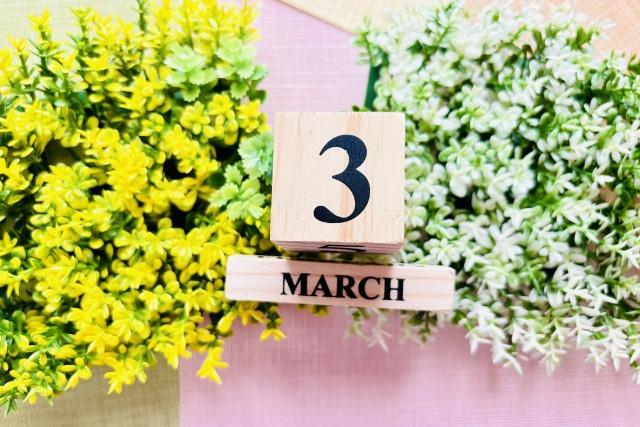
March is a very colourful season for spring flowers in Japan, there’s the gentle pink of cherry and peach blossoms, vibrant multi-colours of tulips, and striking yellow of rape blossoms.
1. Cherry Blossom - 桜 (Sakura)
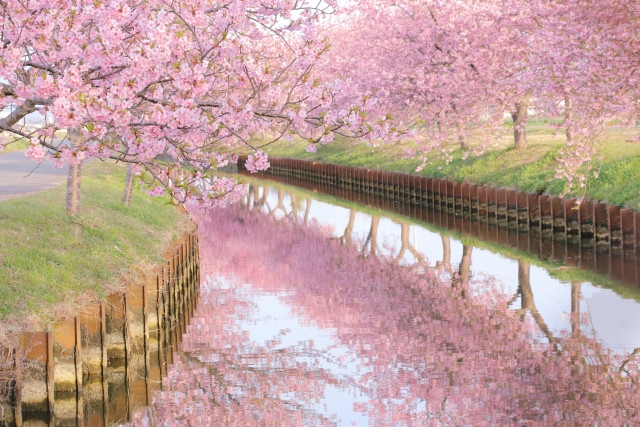
Cherry blossoms (桜, Sakura) are the unofficial national flower of Japan, and the most iconic of Japanese flowers. Cherry blossoms are the harbingers of spring, and have been deeply-rooted since ancient times in Japanese history and culture. There are over 600 types of cherry blossoms in Japan, ranging from white, soft pink, to deep pink.
When Can You See Cherry Blossoms in Japan
The timing for cherry blossom varies by location, weather conditions, and cherry blossom species.
- Somei-Yoshino, which accounts for 80% of cherry blossoms in Japan, typically blooms from mid-March to early April.
- Kawazuzakura and Kanzakura are early-blooming cherry blossoms that bloom from late February to early March.
- Yaezakura are late-blooming cherry blossoms that bloom from late April to May.
Where Can You See Cherry Blossoms in Japan
- Our Tokyo Sakura Spots for Cherry Blossom Viewing article introduces the best locations in Tokyo for cherry blossom viewing separated into three categories - for picnic-style hanami, for enjoying a stroll, for lesser crowds.
- Our Hanami article introduces Japan’s cherry blossom viewing culture and how Hanami is done in Japan, as well as 8 famous cherry blossom spots in Japan.
2. Peach Blossom - 桃の花 (Momo no Hana)・花桃 (Hanamomo)
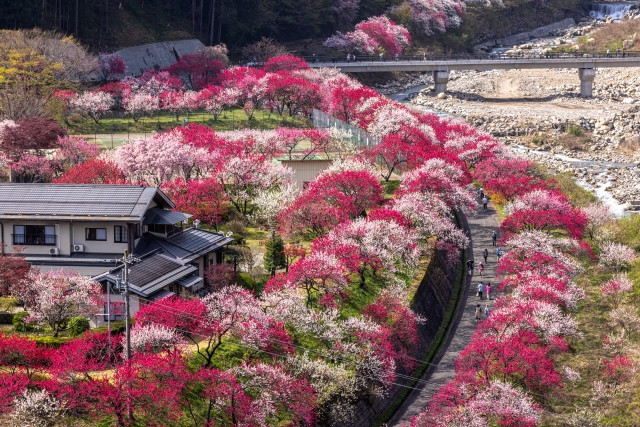
【Hanamomo-no-Sato Peach Blossom Village (花桃の里)】
Peach blossoms (桃の花, Momo no Hana or 花桃, Hanamomo) are well-known as decorations for Hanamatsuri (celebrated on March 3rd, also called Dolls Festival). March 3rd is also known as Peach Festival (桃の節句, Momo no Sekku) as peach blossoms usually flower around March 3rd of the Lunar calendar. The similar colouring , appearance and season of peach and cherry blossoms means that people frequently confuse them but there are ways to tell them apart. Aside from pink, they also come in red and white. Though they are flowers from the peach tree, peach blossom trees are bred for viewing and do not produce fruit.
When Can You See Peach Blossoms in Japan
The typical season for peach blossoms is from late March to early April. Timing varies by region and weather conditions.
Where to See Peach Blossoms in Japan
- Hanamiyama Park (花見山公園) at Fukuoka City, Fukuoka Prefecture
Best Time to Visit: mid-March to mid-April - Hanamomo-no-Sato Peach Blossom Village (花桃の里) at Komagane City, Nagano Prefecture
Best Time to Visit: mid to late March - Koga Kubo Park (古河総合公園) at Koga City, Ibaraki Prefecture
Best Time to Visit: mid to late March - Kobe Station Hanamomo (神戸駅花桃) at Midori City, Gunma Prefecture
Best Time to Visit: late March to mid-April
3. Tulip - チューリップ (Chu-rippu)

【Sakura Furusato Square (佐倉ふるさと広場)】
Tulips (チューリップ, Chu-rippu) though not native to Japan are widely cultivated and appreciated for their beauty throughout the country. There are several places in Japan that are notable for their tulips with extensive tulip fields, and some places even built windmills to match with the tulips like in Holland. Tulip festivals to celebrate the beauty of the flowers with food and drink stalls, performances, and photo spots are also incredibly popular.
When Can You See Tulips in Japan
Tulips in Japan typically from late March to early May, depending on the region and weather conditions. They are flowers that herald the arrival of warmer spring weather in Japan.
Where to See Tulips in Japan
- Sakura Furusato Square (佐倉ふるさと広場) at Sakura City, Chiba Prefecture
Best Time to Visit: Sakura Tulip Festival (end of March to mid-April) - Nabana no Sato (なばなの里) at Kuwana City, Mie Prefecture
Best Time to Visit: mid-March to late April - Showa Memorial Park (国営昭和記念公園) at Tachikawa City, Tokyo Metropolis
Best Time to Visit: late March to mid-April - Flower Festival (mid March to late May) - Tanto Flower Park (たんとう花公園) at Toyooka City, Hyogo Prefecture
Best Time to Visit: Tanto Tulip Festival (mid-April) - Nasu Flower World (那須フラワーワールド) at Nasu District, Tochigi Prefecture
Best Time to Visit: May - Kamiyubetsu Tulip Park (かみゆうべつチューリップ公園) at Yubetsu District, Hokkaido Prefecture
Best Time to Visit: early May to early June
4. Rape Blossom / Rapeseed Flower - 菜の花 (Nanohana)
【Asahi Funagawa Spring Quartet (春の四重奏)】
Rape blossoms (菜の花, Nanohana) are small delicate yellow flowers that bloom in spring and emit a unique fragrance. Vast fields of rape blossoms resemble a yellow carpet. There are many places where a rape blossoms and cherry blossoms can be enjoyed at the same time. The contrast of pink and yellow is incredibly breathtaking.
Rape blossoms are also spring vegetables made into tempura rape blossoms, salads, side dishes, and toppings for chirashizushi.
When Can You See Rape Blossoms in Japan
Rape blossoms bloom typically bloom from February to May, depending on region and climate conditions. Additionally, they generally last quite long. The best timing to see rape blossoms is typically March when blossoms reach peak.
Where to See Rape Blossoms in Japan
- Yokohama-machi Nanohana Field (横浜町の菜の花畑) at Yokohama-machi, Aomori Prefecture
Best Time to Visit: early to mid-May - Isumi Railroad (いすみ鉄道) at Isumi-gun, Chiba Prefecture
Best Time to Visit: early February to early April; cherry blossom & rape blossom in late March - Saitobaru Burial Mounds (横浜町の菜の花畑) at Saito City, Miyazaki Prefecture
Best Time to Visit: late March to early April; coincides with cherry blossoms - Asahi Funagawa Spring Quartet (春の四重奏) at Shimoniikawa-gun, Toyama Prefecture
Best Time to Visit: early to mid-April; view of rape blossoms + tulips + cherry blossoms + snow covered mountain ranges - Nanohana Park (菜の花公園) at Iiyama City, Nagano Prefecture
Best Time to Visit: late April to early May; Iiyama Nanohana Festival (early May)

Other spring flowers in Japan that bloom in March are…
- Hyacinths (ヒヤシンス, Hiyashinsu)
- Freesias (フリージア, Furi-jia)
- Muscari (ムスカリ, Musukari)
- Chinese Violet Cress (紫花菜, Murasakihanana)
- Forget-me-not ( 勿忘草・忘れな草, Wasurenagusa)
Spring Flowers in Japan Best Seen in April
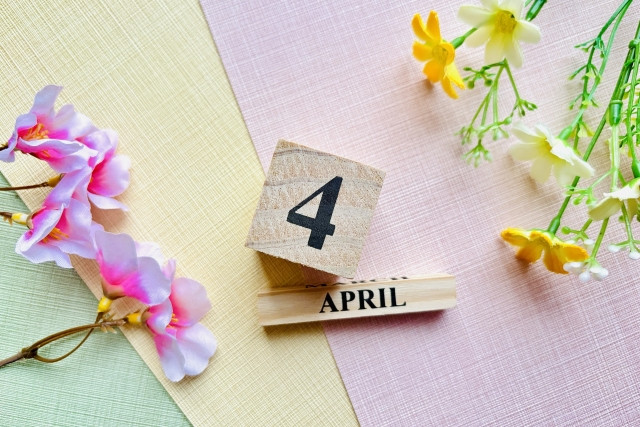
Moving on to spring flowers that can be found in Japan during April. We have an assortment of colourful flowers this time too - baby blue eyes, pink and white moss shibazakura, purple and pink azaleas, and red and orange poppies.
1. Nemophila - ネモフィラ (Nemofira)

【Hitachi Seaside Park (国営ひたち海浜公園)】
Nemophila (ネモフィラ, Nemofira), also known as “Baby Blue Eyes”, are small delicate flowers that are characterised by their blue colour. Vast fields of nemophila in full bloom forming a carpet of blue beneath the sky add elegance and beauty to Japan’s spring landscapes.
When Can You See Nemophila in Japan
The best time to see nemophilas in Japan is typically from mid-April to early May, depending on region and local weather conditions.
Where to See Nemophila in Japan
- Hitachi Seaside Park (国営ひたち海浜公園) at Hitachinaka City, Ibaraki Prefecture
Best Time to Visit: mid-April to early May; coincides with tulips (mid to late April) and daffodils (late March to mid-April) - Showa Memorial Park (国営昭和記念公園) at Tachikawa City, Tokyo Metropolis
Best Time to Visit: late April to mid-May; coincides with several other spring flowers - Flower Festival (mid March to late May) - Lake Yamanaka Flower Park (花の都公園) at Minamitsuru-gun, Yamanashi Prefecture
Best Time to Visit: early May to mid-June; view of Mount Fuji & nemophilas; may coincide with tulips and poppy season - Osaka Maishima Seaside Park (大阪まいしまシーサイドパーク) at Osaka City, Osaka Prefecture
Best Time to Visit: early April to early May; Nemophila Festival (early April to early June)
2. Moss Phlox / Pink Moss - 芝桜 (Shibazakura)
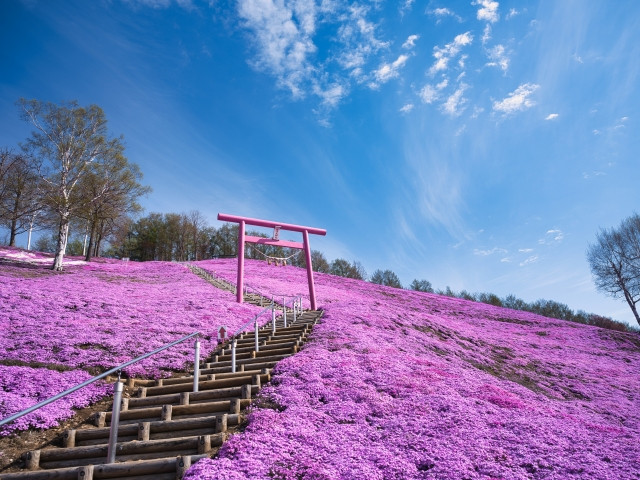
【Higashimokoto Shibazakura Park (東藻琴芝桜公園)】
Moss phlox (芝桜, Shibazakura) is a plant that spreads on the ground like a carpet. They come in various shades of colours including pink, white, purple and lilac. There are several places in Japan that are famous for their impressive fields of shibazakura with endless pink stretching to the horizons.
When Can You See Shibazakura in Japan
The timing for shibazakura varies greatly by location, but they generally bloom from mid April to early May. The season for shibazakura coincides with Golden Week so many people take the opportunity to visit shibazakura spots.
Where to See Shibazakura in Japan
- Higashimokoto Shibazakura Park (東藻琴芝桜公園) at Abashiri-gun, Hokkaido Prefecture
Best Time to Visit: May - Hitsujiyama Park (ひがしもこと芝桜公園) at Chichibu City, Saitama Prefecture
Best Time to Visit: mid-April to early May - Misato Shibazakura Park (みさと芝桜公園) at Takasai City, Gunma Prefecture
Best Time to Visit: early April to early May - Fuji Motosuko Resort (富士本栖湖リゾート) at Minamitsuru-gun, Yamanashi Prefecture
Best Time to Visit: Fuji Shibazakura Festival (mid-April to late May); view of partially snow covered Mount Fuji and shibazakura - Flower Village Kamu no Sato (flowervillage 花夢の里) at Sera-gun, Hiroshima Prefecture
Best Time to Visit: mid-April to early May; coincides with nemophila in mid-April
3. Azalea / Rhododendron - ツツジ (Tsutsuji)
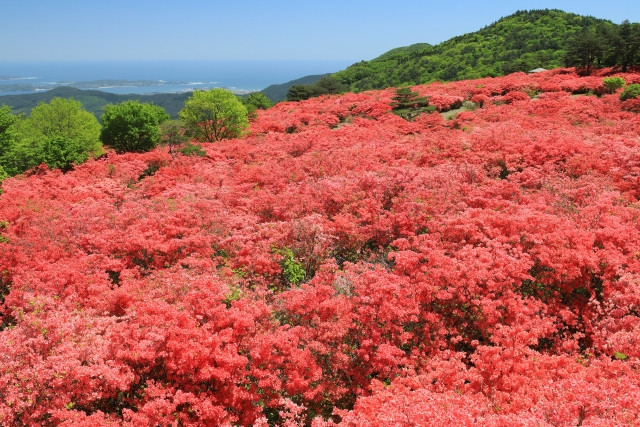
【Mount Tokusenjo (徳仙丈山)】
Azaleas (ツツジ, Tsutsuji) are flower shrubs with trumpet-like flowers that bloom in various shades of colour. Red and dark pink tsutsuji are the most commonly seen, but there are also white and purple ones. Tsutsuji are easy to grow and so can be seen almost everywhere in Japan including neighbourhoods, roadsides, and of course, gardens and parks.
When Can You See Tsutsuji in Japan
Tsutsuji are flowers that bloom during warmer weather in spring, typically from April to May. Timing varies by location and weather conditions.
Where to See Tsutsuji in Japan
Tsutsuji can be easily seen and enjoyed in many Japanese neighbourhoods and public parks, but if you are looking for more impressive views, check out these locations.
- Mount Tokusenjo (徳仙丈山) at Kesennuma City, Miyagi Prefecture
Best Time to Visit: mid-April to late May - Kasama Tsutsuji Park (笠間つつじ公園) at Kasama City, Ibaraki Prefecture
Best Time to Visit: Kasama Tsutsuji Festival (mid April to early May) - Shiofune Kannon Temple (塩船観音寺) at Ome City, Tokyo Metropolis
Best Time to Visit: mid-April to early May - Nagushiyama Park (長串山公園) at Sasebo City, Nagasaki Prefecture
Best Time to Visit: Tsutsuji Festival (April)
4. Poppy - ポピー (Popi-)・ヒナゲシ (Hinageshi)
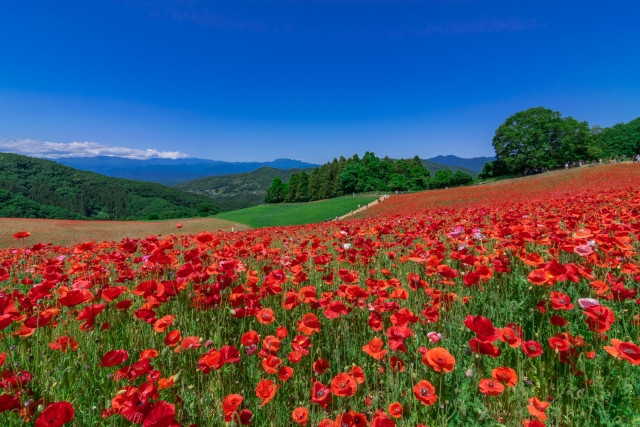
【Chichibu Highland Ranch “Tenku no Poppy” (秩父高原牧場 天空のポピー) 】
Poppies (ポピー, Popi- or ヒナゲシ, Hinageshi) are characterised by their adorable fluttery petals. Poppy fields bring vibrant energising colours of bright red or brilliant orange, adding a pop of colour to the natural surroundings.
When Can You See Poppies in Japan
Poppies in Japan typically bloom from late April to early June, depending on location and weather conditions. The peak bloom is usually around May.
Where to See Poppies in Japan
- Showa Memorial Park (国営昭和記念公園) at Tachikawa City, Tokyo Metropolis
Best Time to Visit: mid to late May - Flower Festival (mid March to late May) - Michinoku National Park (国営みちのく杜の湖畔公園) at Shibata-gun, Miyagi Prefecture
Best Time to Visit: mid to late May - Chichibu Highland Ranch “Tenku no Poppy” (秩父高原牧場 天空のポピー) at Chichibu City, Saitama Prefecture
Best Time to VIsit: mid-May to early June - Ikoma Plateau (生駒高原) at Kobayashi City, Miyazaki Prefecture
Best Time to Visit: late April to mid-May; Poppy Festival (mid-April to mid-May
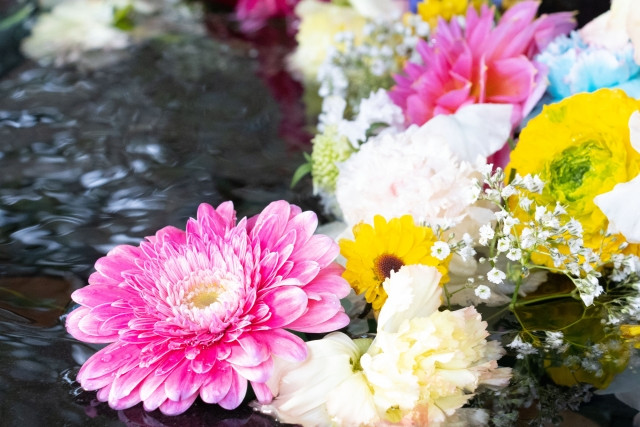
Other spring flowers in Japan in the month of April are…
- Lily of the Valley (スズラン, Suzuran)
- Dianthus (撫子・ナデシコ, Nadeshiko)
- Dogwood (ハナミズキ, Hanamizuki)
- Anemone / Windflower (アネモネ, Anemone)
- Gerbera / African Daisy (ガーベラ, Ga-bera)
- Lilac (ライラック, Rairaku)
Spring Flowers in Japan Best Seen in May
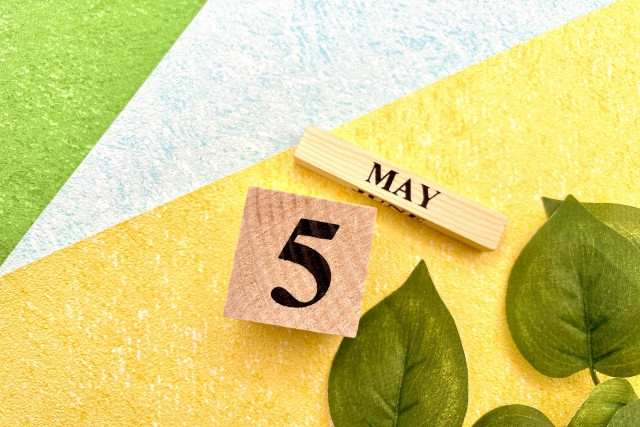
1. Lupine - ルピナス (Rupinasu)
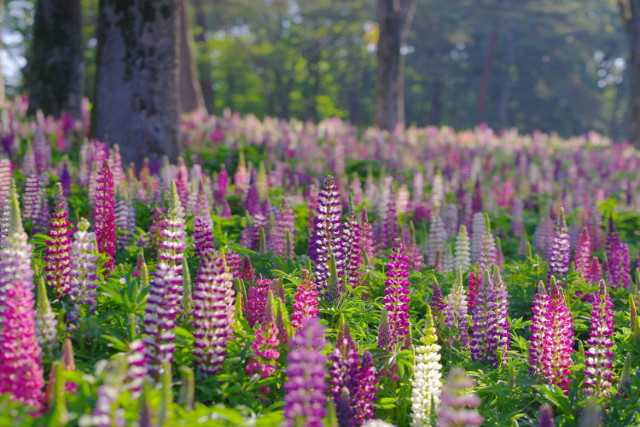
Photo from PR Times.【Musashi Kyuryo National Government Park (国営武蔵丘陵森林公園)】
Lupine (ルピナス, Rupinasu) are characterised by their tall spikes adorned with clusters of pea-sized flowers. They come in a variety of colours including purple, pink, white, blue, orange and yellow. A field of multi-coloured lupine is a wonderful sight to behold. There are even varieties that feature multiple colours adding to their visual appeal.
When Can You See Lupine in Japan
Lupine have long blooming periods. In Japan, the best timing for lupine is generally in May, but this varies greatly by location and weather conditions. Lupine at places with warmer weather bloom as early as March or April, while northern areas bloom in the beginning of summer.
Where to See Lupine in Japan
- Tsukuiko Shiroyama Park (津久井湖城山公園) at Sagamihara City, Kanagawa Prefecture
Best Time to Visit: mid-May - Musashi Kyuryo National Government Park (国営武蔵丘陵森林公園) at Hiki-gun, Saitama Prefecture
Best Time to Visit: mid-April to mid-May; coincides with delphiniums (late April to early May) - New York Lamp Museum & Flower Garden (ニューヨークランプミュージアム&フラワーガーデン) in Izu Ocean Park (伊豆海洋公園) at Ito City, Shizuoka Prefecture
Best Time to Visit: March to early May - Tourism Farm Hana Hiroba (観光農園 花ひろば) at Chita-gun, Aichi Prefecture
Best Time to Visit: mid-April to early June - Flower Land Kamifurano (フラワーランドかみふらの) at Sorachi-gun, Hokkaido Prefecture
Best Time to Visit: June
2. Rose - 薔薇 (Bara)
【Yokohama English Garden (横浜イングリッシュガーデン)】
In Japan, there are two big seasons for roses (薔薇, Bara), in spring and autumn. Spring roses are said to be better than autumn roses, with greater abundance of flowers. Roses are cultivated widely in Japan, with notable famous rose gardens across the country. Large-scale rose gardens feature various varieties of roses in an assortment of colours.
Spring festivals or rose festivals are frequently held in conjunction with the season for roses. We recommend trying rose tea and rose flavoured ice-cream that may be sold at rose gardens.
When Can You See Roses in Japan
Spring roses are typically from late spring to early summer with peak bloom occurring around May to June, depending on climate and weather conditions. As for autumn roses, they typically bloom in Japan from late September to November.
Where to See Roses in Japan
- Keisei Rose Garden (京成バラ園) at Yachiyo City, Chiba Prefecture
Best Time to Visit: theme for rose festival changes every year (late April to early June) - Kyu-Furukawa Gardens (旧古河庭園) at Kita-ku, Tokyo Metropolis
Best Time to Visit: Rose Festival (late April to late June) - Yokohama English Garden (横浜イングリッシュガーデン) at Yokohama City, Kanagawa Prefecture
Best Time to Visit: Rose Festival (May) - Ibaraki Flower Park (いばらきフラワーパーク) at Ishioka City, Ibaraki Prefecture
Best Time to Visit: mid-May to late June - Amaraki Rose Park (荒牧バラ公園) at Itami City, Hyogo Prefecture
Best Time to Visit: May to June
3. Wisteria - 藤 (Fuji)

【Kawachi Fujien Wisteria Garden (河内藤園)】
Wisteria (藤, Fuji) is a vine plant that is characterised by its soft purple flowers. There are many varieties of fuji cultivated in Japan, but the most common are Japanese Wisteria and Chinese Wisteria. Aside from light purple, fuji also come in white, light red, and yellow colours. Japanese Fuji is known for its flower clusters and is often featured in gardens and parks around the country. In particular, wisteria trellises, made of tall wooden shelves and entwining wisterias forming purple flower tunnels, are a sight to behold in Japan.
When Can You See Fuji in Japan
Fuji in Japan blooms through April and May, depending on the species, region and weather conditions. The best time to see Fuji is usually in early to mid-May.
Where to See Fuji in Japan
- Ashikaga Flower Park (あしかがフラワーパーク) at Ashikaga City, Tochigi Prefecture
Best Time to Visit: mid-April to mid-May; fuji bloom in order from light red to purple, white to yellow - Kawachi Fujien Wisteria Garden (河内藤園) at Kitakyushu City, Fukuoka Prefecture
Best TIme to Visit: early May - Fuji no Saku Oka (ふじの咲く丘) at Fujioka City, Gunma Prefecture
Best Time to Visit: Fujioka Fuji Festival (late April to mid-May) - Byakugo-ji Temple (白毫寺) at Tamba City, Hyogo Prefecture
Best Time to Visit: early to mid-May - Fuji Park (藤公園) at Waki-cho, Okayama Prefecture
Best Time to Visit: late April to mid-May

Other spring flowers in Japan in the month of May are…
- Carnation (カーネーション, Kan-ne-shon)
- Chinese Peony (芍薬・シャクヤク, Shakuyaku)
- Tree Peony (牡丹, Botan)
- Iris (菖蒲・アヤメ, Ayame)
- Lavender (ラベンダー, Rabenda-)
- Marigold (マリーゴールド, Mari-go-rudo)
Things to Look Out for When Going Flower-viewing
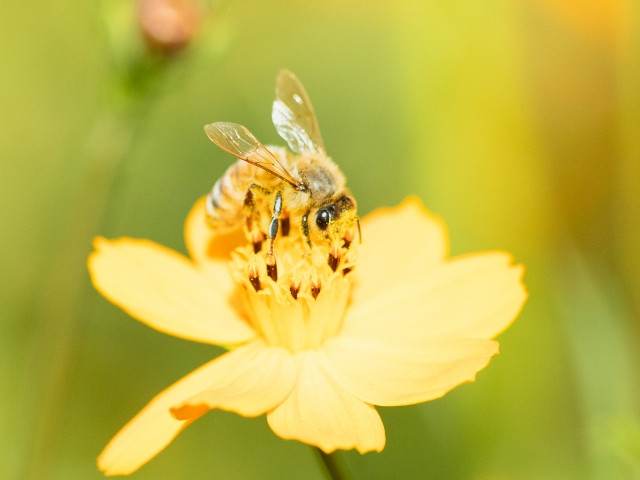
When going flower-viewing in Japan, or anywhere else in the world for that matter, there are some things to keep in mind to ensure you have a good experience. Here are some things to look out for:
Hay Fever (Pollen Allergy)
If you have hay fever (花粉症, Kafunshou), then take adequate care to prevent or minimise your allergies. Some things you can do to help prevent hay fever are wearing pollen prevention masks, pollen protective eyewear, wearing a hat, and wearing clothing that pollen does not adhere to easily. If you need to buy hay fever medication, you can find 10 recommendations for medicines available in Japan in our article here.
Bees
Spring is the season of flowers, but also the season of spring bugs like caterpillars, butterflies, and more. Bees in particular can be dangerous if you have severe bee allergies and flower fields tend to have many of them. Take safety measures like carrying an EpiPen in case of allergic reactions, and inform your travel companions on how to use it. Families with children should keep an eye on them, keep children away from bees, and educate children about how not to aggravate bees.
Sunburn
Sunburn can also be a concern when spending time outdoors, especially during flower-viewing excursions. Many people underestimate how damaging the sun is during spring as the temperatures are pleasant and cool. Generously apply high SPF sunscreen on exposed areas, paying extra attention to your face, neck, arms and legs, and reapply every 2 to 3 hours.
Weather Conditions and Blooming Period
Flower blooming conditions are different every year and from place to place. Always check the latest flower conditions on the facilities’ official website or social media to ensure it will not be a disappointing experience. In addition, outdoor activities are affected greatly by weather conditions, so check the weather forecast before heading out.
To Close

Japan’s nature and seasonal phenomena are a must-see when visiting, and spring flowers are a definite must when visiting during the spring months from March to May. Now that you know what spring flowers to expect in Japan, have fun planning your spring itinerary.















.jpg)



















